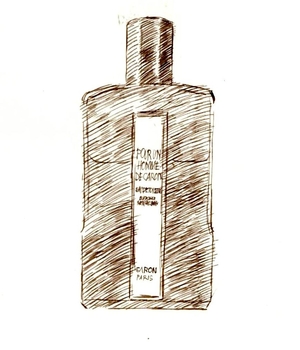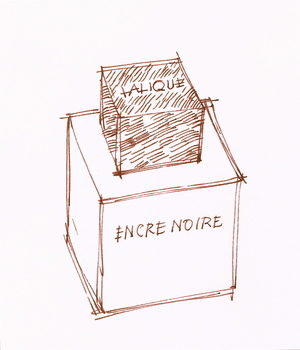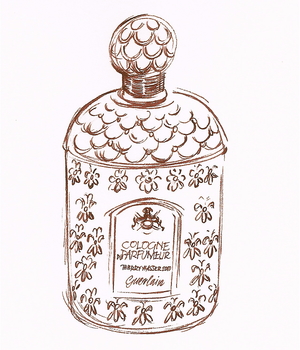Tagged With ‘musk’
Caron
Pour un Homme
12 June, 2015
 I’ve known about Caron’s Pour un Homme for many years – it’s often been hailed as one of the classics of men’s perfumery, and a couple of friends used to enthuse about it – but on the odd occasions when I’d tried it I couldn’t really see what there was to get so excited about. Despite its heritage it came in a cheap-looking bottle, and the testers I smelled did nothing much for me; to be honest I thought it was a bit dull.
I’ve known about Caron’s Pour un Homme for many years – it’s often been hailed as one of the classics of men’s perfumery, and a couple of friends used to enthuse about it – but on the odd occasions when I’d tried it I couldn’t really see what there was to get so excited about. Despite its heritage it came in a cheap-looking bottle, and the testers I smelled did nothing much for me; to be honest I thought it was a bit dull.
But then I got a new bottle, and either Richard Fraysse, Caron’s in-house perfumer, has smartened up the fragrance formula, or the scales have fallen from my eyes. The new bottle is certainly tidier than the old ones were: even my enthusiastic friends admitted that it looked like members of the Caron family had stuck the labels on, rather wonkily, by hand.
Actually the Carons haven’t been involved with Parfums Caron since the early 1900s, when Anne-Marie Caron sold her family perfume shop in the Rue de la Paix in Paris to the brothers Ernest and Raoul Daltroff. The brothers came from a cosmopolitan Russian Jewish family – their father ran a railway company in Saône et Loire – but for some reason they decided to get into perfume.
There doesn’t seem to be any record of Ernest training in perfumery, but he evidently had a natural talent, and he was helped, from 1906, by a one-time dressmaker called Félicie Wanpouille, who became what we’d now call the company’s creative director. Between them they developed a series of perfumes, with striking packaging and beautiful Baccarat bottles, and in 1911 they had their first big success with Narcisse Noir (still available but completely reformulated and apparently nothing like the original).
In 1919 came Tabac Blond, which for many contemporaries captured the spirit of the so-called Jazz Age, and more particularly to the outrageous young women who had taken to smoking cigarettes in public (again it’s still on the shelves, but the modern version smells nothing like the original, which was more like the wonderful and still untampered-with Knize Ten). Daltroff made Félicie Wanpouille co-owner of Caron in 1922.
Pour un Homme arrived in 1934, and has since established itself as one of the all-time fragrance classics. On the face of it it’s a simple enough smell: lavender, lavender and more lavender. But perfumes (at least good ones) are rarely as simple as they might seem, and Pour un Homme is no exception.
Like Guerlain’s ground-breaking Jicky from 1889, it mixes lavender with vanilla, but with very different results: sniffing them side by side is a good reminder of why a list of ingredients tells you very little about what a perfume will actually smell like. Jicky has a strange, sexy but disconcerting smell, which has sometimes been compared with cat wee, and it’s the (mostly synthetic) vanilla that you notice first.
Pour un Homme, by contrast, smells very like real lavender when you brush its leaves, and (to me at least) it’s got an almost minty cool freshness. It’s a while before you smell the vanilla – and actually if I didn’t know it was in there I’m not sure I’d have even noticed. Though the lavender smell stays for a long time, this extra touch of vanilla (plus some nice but unobtrusive musks) adds a gently comforting character, without being sweet or cloying in any way.
All in all I think Pour un Homme is a lovely fragrance, if not one that’s likely to get you noticed at a party; this is something I’d wear for myself rather than for other people.
As for its brilliant creator, Ernest Daltroff, he came to a rather sad end. Though he escaped the Nazi invasion of France in 1939, moving first to Canada and then New York, he was by this time in his seventies, frail and depressed, and he died just three years later.
Félicie Wanpouille continued running Caron until she retired in 1962, when she sold the company to Parfums Revillon. In 1967 the brand was bought by the American pharmaceuticals company AH Robins, which opened a flagship store on the Avenue Montaigne. In 1988 Caron was sold again, this time to a French hair-products and cosmetics group, whose owner, Patrick Alès, had long admired the brand. Today it’s run by Patrick’s son Romain. Long may it prosper.
Lalique
Encre Noire
15 April, 2015
 Calling a perfume ‘black ink’ has intriguing connotations. ‘Black’ or ‘Noir(e)’ has been the perfume industry’s shorthand for ‘edgy’ ever since the 1998 launch of the striking but hard-to-wear Bulgari Black. Among the many followers in its wake we’ve had Ambre Noir, 1881 Black, Armani Privé Cuir Noir, Bois Noir, Coco Noir, Cologne Noir, Dahlia Noir, Datura Noir, Eau Noir, Fourreau Noir, even (I kid you not) Hello Kitty Noir.
Calling a perfume ‘black ink’ has intriguing connotations. ‘Black’ or ‘Noir(e)’ has been the perfume industry’s shorthand for ‘edgy’ ever since the 1998 launch of the striking but hard-to-wear Bulgari Black. Among the many followers in its wake we’ve had Ambre Noir, 1881 Black, Armani Privé Cuir Noir, Bois Noir, Coco Noir, Cologne Noir, Dahlia Noir, Datura Noir, Eau Noir, Fourreau Noir, even (I kid you not) Hello Kitty Noir.
So Encre Noire (which was launched in 2006) follows a bit of a bandwagon, though at least its name is better than most. It’s a nostalgic name, since hardly anyone uses ink (black or otherwise) these days, yet it’s evocative too – I can kind of imagine the smell of black ink, even though I must have been a teenager the last time I opened an actual bottle of the stuff.
Whatever you think about the name, Encre Noire is a fine addition to the many men’s perfumes to be based on the smell of vetiver, the vigorous tropical grass whose roots have a wonderful dry, earthy, slightly musky scent. My all-time favourite is Guerlain’s simply-named Vétiver, which starts with a burst of lemony freshness, but Encre Noire foresakes such tricks and sticks resolutely with vetiver all the way through.
I say ‘all the way through’, but of course it’s actually a bit more complicated than that, thanks to Nathalie Lorson, senior perfumer at the giant Swiss fragrance company Firmenich. When she created Encre Noire she cleverly smoothed off some of vetiver’s rough edges, adding tiny amounts of cypress extract (which has a dry, woody, slightly resinous smell), as well as synthetic musk and so-called ‘cashmere wood’. This is actually 2,3,5,6,7-hexahydro-1,2,3,3-pentamethyl-4h-inden-4-one, a chemical sold under the brand name of Cashmeran, which is widely used in perfumery (and household products) and has a soft, gently woody smell.
The final result an appealing and long-lasting perfume, though some people are always going to find vetiver too dry and bitter-smelling for their taste. As for the bottle, a black glass cube with a square wood-effect cap, I like its inkwell look, but its glossy surfaces all too quickly get smeared with fingerprints, and the lettering is so spare – just a bare ENCRE NOIRE in thin white sans-serif capitals – that (to me at least) it ends up looking a bit cheap and half-considered, though I’m sure it was anything but.
Minor gripes aside, this is a fine perfume, and even if, in the end, I think it’s unlikely to supplant Guerlain’s Vétiver in my affections, I think its popularity is well deserved.
Guerlain
Cologne du Parfumeur
6 August, 2014
 If there’s one scent that appeals to pretty much everyone then surely it’s eau-de-cologne, the zesty, refreshing blend of lemon and herbs whose (probably medicinal) origins are lost in the mists of time. Its oldest surviving surviving incarnation is the German No. 4711 Echt Kölnisch Wasser from – where else – Cologne, which you can buy for not very much from pretty much anywhere, but there are hundreds of other versions, from the cheap and nasty all the way up to Chanel’s divine (and divinely expensive) Eau de Cologne.
If there’s one scent that appeals to pretty much everyone then surely it’s eau-de-cologne, the zesty, refreshing blend of lemon and herbs whose (probably medicinal) origins are lost in the mists of time. Its oldest surviving surviving incarnation is the German No. 4711 Echt Kölnisch Wasser from – where else – Cologne, which you can buy for not very much from pretty much anywhere, but there are hundreds of other versions, from the cheap and nasty all the way up to Chanel’s divine (and divinely expensive) Eau de Cologne.
The basic ingredients of eau-de-cologne are extracts of citrus fruits, which give it its instant freshness, blended with a variety of herbs, usually including lavender and rosemary, which add extra staying-power and warmth. It’s more of a style than a formula, and every different eau-de-cologne has a slightly different combination of ingredients, though they all share a broadly similar character. They all suffer from one drawback, too, which is that they quickly fade away on the skin.
As one of the most historic perfume companies, Guerlain has produced a number of different takes on eau-de-cologne over the years, starting with Eau de Cologne Impériale in 1853, followed by Eau de Cologne du Coq in 1894, the glorious Eau de Fleurs de Cédrat in 1920, and Eau de Guerlain in 1974.
Cologne du Parfumeur was launched in 2010, and is the first not to have been dreamed up by a member of the Guerlain family. Its creator, the Swiss perfumer Thierry Wasser, became the company’s in-house perfumer in 2008, after the retirement of Jean-Paul Guerlain. Wasser’s interpretation of the classic eau-de-cologne retains plenty of citrusy zing, but with more orange than lemon in the mix, which makes it smell slightly sweeter and less astringent than the general run of colognes. The blend of orange used here is particularly ‘green’, which makes a bit more sense if you think of orange flowers surrounded by their glossy dark-green leaves.
Wasser accentuates this ‘greenness’ with tiny amounts of fresh-smelling mint, as well as plenty of lavender and rosemary, those classic eau-de-cologne herbs. I think I also smell a little bit of bracing juniper, which gives Voyage d’Hermès its gin-and-tonic swing. Overall it’s a gentle, appealing scent, and Wasser has given it extra staying-power thanks, it seems, to the inclusion of long-lasting synthetic musks, which add their own soft, slightly sensual touch.
Cologne du Parfumeur comes in Guerlain’s classic ‘bee’ bottle, with fish-scale patterned shoulders, 69 stylised embossed bees on the sides and a rather cheap-feeling plastic top, though customised, hand-gilded versions are available for a suitable fee. What’s most interesting is its label, which includes ‘Thierry Wasser 2010’ – a new departure for Guerlain, and one of the earlier signs that perfumers had started becoming celebrities in their own right.